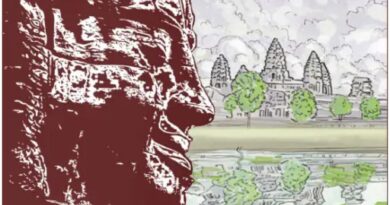នៅព្រឹកថ្ងៃទី០៦ ខែកក្កដា ឆ្នាំ២០២៣នេះ នៅមជ្ឈមណ្ឌលបណ្តុះបណ្តាលអង្គរ នៃអាជ្ញាធរជាតិអប្សរា បានរៀបចំកិច្ចប្រជុំមួយស្តីពី៖ ការកំណត់អត្តសញ្ញាណអ្នកពាក់ព័ន្ធ និងសិទ្ធ អំពីការបំរែបំរួលអាកាសធាតុ និងការបន្សុំានៅតំបន់បេតិកភណ្ឌ ដោយមានការចូលរួមពី ឯកឧត្តម យិត ចាន់ដារដ្ឋ អគ្គនាយករង តំណាងឯកឧត្តមបណ្ឌិត ហង់ ពៅ អគ្គនាយកអាជ្ញាធរជាតិអប្សរា លោកប្រធាន អនុប្រធាននាយកដ្ឋាន តំណាងស្ថាប័នអង្គការដៃគូ តំណាងអង្គភាពនគរបាលបេតិកភណ្ឌ តំណាងមន្ទីរបរិស្ថានខេត្ត អាជ្ញាធរក្នុងតំបន់ ព្រមទាំងមន្ត្រី – បុគ្គលិកអាជ្ញាធរជាតិអប្សរាជាច្រើនរូបទៀត។ កិច្ចប្រជុំនេះផ្តោតសំខាន់ទៅលើ ការចូលរួមចំណែកផ្សព្វផ្សាយ ការចែករំលែកចំណេះដឹង ការពិភាក្សារួមគ្នាអំពី ការបំរែបំរួលអាកាសធាតុ ដែលអាចមានផលប៉ះពាល់ជាមួយនិងបេតិកភណ្ឌ។
មានប្រសាសន៍ក្នុងឱកាសនោះ ឯកឧត្តម យិត ចាន់ដារដ្ឋ អគ្គនាយករងអាជ្ញាធរជាតិអប្សរា បានលើកឡើងថា ការបំរែបំរួលអាកាសធាតុ គឺជាបាតុភូតទូទៅសម្រាប់សាកលលោកទាំងមូល មិនមែនកើតឡើងតែនៅប្រទេសកម្ពុជាមួយនោះឡើយ។ ដូច្នេះបើសិនជាយើងបានគ្រប់គ្រងបានល្អប្រសើរ ផលប៉ះពាល់គឺមានតិច ជាពិសេសសម្រាប់តំបន់បេតិកភណ្ឌ។
ឯកឧត្តមបន្តទៀតថា អាជ្ញាធរជាតិអប្សរាមិនមែនទើបតែគិតអំពីបញ្ហាការបំរែបំរួលអាកាសនោះទេ ជាច្រើនឆ្នាំមកហើយ ដែលអាជ្ញាធរជាតិអប្សរា បានយកចិត្តទុកដាក់ខ្ពស់ទៅលើវិធានការណ៍មួយច្បាស់លាស់ ក្នុងការទប់ទល់ និងបំរែបំរួលអាកាសធាតុនេះ។ ដែលអាចជះប៉ះពាល់ជាវិជ្ជមាន ទៅលើរមណីយដ្ឋានអង្គរដែលជាបេតិកភណ្ឌពិភព មានដូចជា៖ សកម្មភាពថែរក្សាទេសភាពវប្បធម៌ មានទាំងប្រាសាទ ទឹក និងព្រៃឈើ រួមបញ្ជូលគ្នា។
សកម្មភាពដាំដើមឈើឡើងវិញ នៅតំបន់រមណីយដ្ឋានអង្គរបានធ្វើឡើងជារៀងរាល់ឆ្នាំ រហូតមកដល់បច្ចុប្បន្នសម្រេចបានប្រមាណ២លានដើម បន្ថែមពីនេះការចែកជូនកូនឈើ ជូនសាធារណជនទូទៅយកទៅដាំដុះបន្ត។ ការស្តារឡើងវិញនូវប្រព័ន្ធធារាសាស្ត្រពីបុរាណ ជាការងារមួយដ៏ធំរបស់អាជ្ញាធរជាតិអប្សរា ដោយបានស្តារប្រឡាយបុរាណ ត្រពាំងបុរាណ ការស្តារនិងបញ្ជូលទឹកក្នុងកសិន្ធុធំៗនៅក្នុងតំបន់អង្គរ។ ការបន្តសកម្មភាពជួសជុល និងបញ្ជូលទឹកនៅតាមបារាយណ៍បុរាណជាច្រើនទៀត នៅជុំវិញរមណីយដ្ឋានអង្គរ និងបន្តសហការជាមួយស្ថាប័នដៃគូនានា តាមដានអំពីគុណភាពខ្យល់ នៅតំបន់រមណីយដ្ឋានអង្គរជាដើម៕
អត្ថបទ៖នាយកដ្ឋាន ស្រាវជ្រាវ បណ្តុះបណ្តាល និងផ្សព្វផ្សាយ
រូបភាព៖លោក ហ៊ុ រិទ្ធី
APSARA National Authority holds a meeting on the Identification of Stakeholders and Rights of Climate Change and Adaptation in Heritage Site
On 06 July 2023, at the Angkor Training Center of APSARA National Authority, a meeting is held on: Identification of Stakeholders and Rights of Climate Change and Adaptation in Heritage Site with the participation of H.E. Yit Chandaroat, Deputy Director General, representative of H.E. Dr. HANG Peou, Director General of APSARA National Authority, Department Directors, Representative of Organizations, Heritage Police Units, Provincial Departments of Environment, Local Authorities and many other officials and staff of APSARA National Authority. The meeting focuses on contributing to the dissemination of knowledge sharing, and joint discussions on climate change that may have an impact on heritage.
Speaking on that occasion, H.E. Yit Chandaroat said that climate change is a common phenomenon for the whole world, not just in Cambodia. So if we manage well, the impact is minimal, especially for heritage sites.
He added that the APSARA National Authority is not just thinking about climate change, for many years the APSARA National Authority has been paying close attention to clear measures to prevent climate change, which can have an impact on Angkor World Heritage sites, such as cultural landscaping activities, including temples, water, and forestry.
Reforestation activities in the Angkor area have been carried out every year until now, reaching about 2 million trees, in addition to the distribution of seedlings to the public to continue planting. The restoration of the ancient irrigation system is a major task of the APSARA National Authority, with the restoration of ancient canals, and ancient ponds, and the replenishment of large reservoirs in the Angkor area. Continuing to repair and replenish water in many other ancient barays around Angkor and continue to cooperate with partner institutions to monitor air quality in Angkor.
Article: Department of Research, Training, and Communication
Photos: Mr. Hum Rithy
Share:
Our Latest News

សេចក្តីជូនដំណឹង ស្ដីពីការដាក់ឱ្យប្រើប្រាស់សាកល្បងកម្មវិធី Visit Angkor – 09 May 2025
ដើម្បីទាញយកកម្មវិធីVisit Angkor៖




